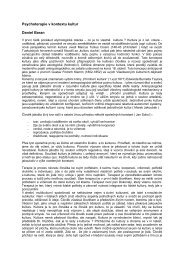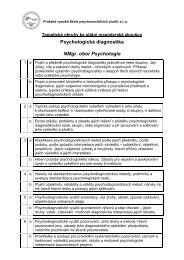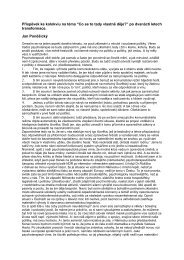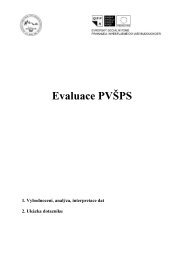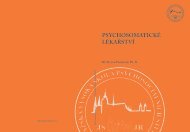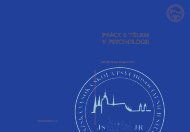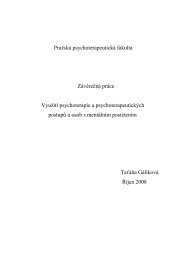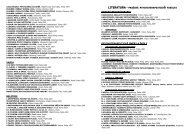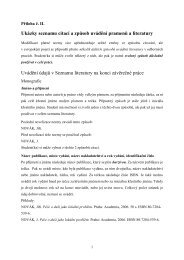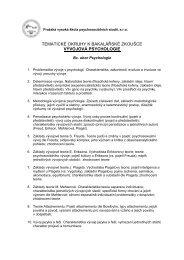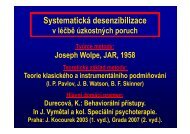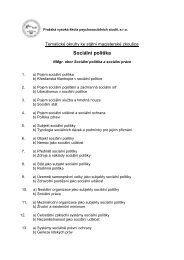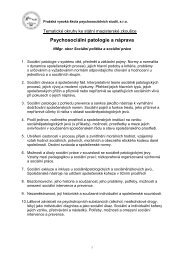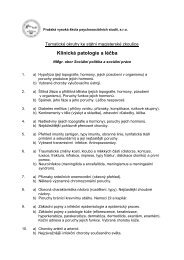New Sources of Fear in a Late Modern Society: The Globalization of ...
New Sources of Fear in a Late Modern Society: The Globalization of ...
New Sources of Fear in a Late Modern Society: The Globalization of ...
Create successful ePaper yourself
Turn your PDF publications into a flip-book with our unique Google optimized e-Paper software.
106<br />
NEW SOURCES OF FEAR IN A LATE MODERN SOCIETY<br />
to provide a universal def<strong>in</strong>ition <strong>of</strong> fear ended with the statement, “It is my pessimistic<br />
conclusion that fear is not def<strong>in</strong>able at the present time” (Matthen, 1998, p. 106). <strong>The</strong><br />
difficulties associated with def<strong>in</strong><strong>in</strong>g fear stem from attempts to grasp the concept <strong>in</strong> an<br />
<strong>in</strong>terdiscipl<strong>in</strong>ary manner: Matthen comments upon this as a “clash <strong>of</strong> methodologies<br />
used <strong>in</strong> the study <strong>of</strong> emotions” (1998, p. 105), assum<strong>in</strong>g the perspective <strong>of</strong> a philosopher<br />
weigh<strong>in</strong>g, from an evolutionary perspective, the contradictions and paradoxes which<br />
emerge dur<strong>in</strong>g comparisons <strong>of</strong> the methodologies <strong>of</strong> ethnologists and psychologists to<br />
the notion <strong>of</strong> fear. <strong>The</strong> need arises to catalogue fear among biological universals and<br />
Matthen ends his particularly thought-provok<strong>in</strong>g text with these words: “It really is the<br />
bus<strong>in</strong>ess <strong>of</strong> empirical science to furnish the basis <strong>of</strong> a biological def<strong>in</strong>ition <strong>of</strong> fear, and the<br />
result may well not be a perfect fit with the <strong>in</strong>tuitions <strong>of</strong> philosophers” (Matthen, 1998,<br />
p. 132).<br />
“Genes and environment, biological and social sciences, the theory <strong>of</strong> learn<strong>in</strong>g<br />
and the complexities <strong>of</strong> drug addiction, hormones and neurons, personality traits<br />
and psychopathology” (Gray, 1987, p. vii) – Thus, it is possible to study fear from<br />
all <strong>of</strong> these viewpo<strong>in</strong>ts and perhaps more. <strong>Fear</strong> is undoubtedly an emotion to which<br />
psychology pays relentless attention and names such as Basowitz, Cattell, Freud,<br />
Izard, Lazarus, Levitt, Plutchik, Spielberger and Watson belong among the giants<br />
<strong>of</strong> the field and cannot be overlooked dur<strong>in</strong>g the study <strong>of</strong> this emotion. Drvota and<br />
Vymětal belong among the Czech authors, who have devoted particular efforts to<br />
study<strong>in</strong>g this subject. <strong>The</strong> latter def<strong>in</strong>es fear as “an unpleasant experience tied to<br />
a specific object or situation, which creates a concern regard<strong>in</strong>g peril <strong>in</strong> the <strong>in</strong>dividual.<br />
Thus, it is a reaction to known dangers and has a signal<strong>in</strong>g and defensive<br />
function. As an experience, the emotion encompasses tension, disquiet, tightness<br />
and even paralysis” (Vymětal, 2004, p. 12).<br />
<strong>The</strong> likely simplest possible approach to the study <strong>of</strong> fear is <strong>of</strong>fered by radical<br />
behaviorists, who would likely do just as well without the term fear and <strong>in</strong>stead<br />
rely on avoidance behavior. Gray (1987, p. 34) notes that: “the attempt to def<strong>in</strong>e<br />
fear as avoidance behavior is usually preparatory to the conclusion - very welcome<br />
to the radical behaviorists, who want noth<strong>in</strong>g to <strong>in</strong>tervene between stimulus<br />
and response – that we have no need for the concept <strong>of</strong> fear at all, s<strong>in</strong>ce we can always<br />
talk <strong>of</strong> avoidance behavior <strong>in</strong>stead”. So is the term fear really unnecessary?<br />
So long as we merely study the <strong>in</strong>ter-relationships <strong>of</strong> the stimulus-response, we<br />
can do without the term fear. <strong>The</strong> basic questions, with which we beg<strong>in</strong> the study<br />
<strong>of</strong> fear, can be described thus: “(1) what are the conditions which give rise to fear?<br />
(2) what are the conditions which affect susceptibility to fear, or ‘fearfulness’?”<br />
(Gray, 1987, p. 2). Gray (1987, p. 2) prefers “to regard fear as a state, not <strong>of</strong> m<strong>in</strong>d,<br />
but <strong>of</strong> the neuro-endocr<strong>in</strong>e system” – with which we are <strong>in</strong> agreement.<br />
<strong>Fear</strong> is <strong>of</strong>ten connected with anxiety. It can be argued that these two terms need<br />
not always be differentiated. But how to def<strong>in</strong>e the differences between fear and



